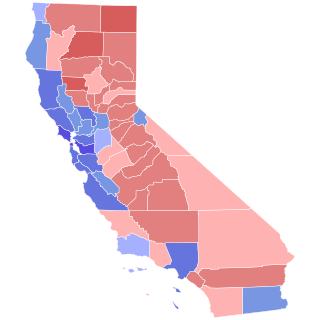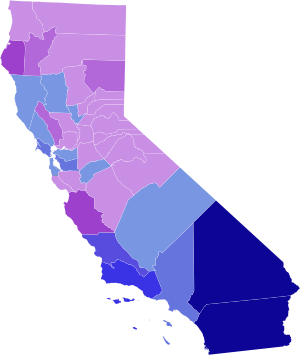
The 1994 California gubernatorial election was held on November 8, 1994, in the midst of that year's "Republican Revolution". Incumbent Republican Pete Wilson easily won re-election over his main challenger, Democratic State Treasurer Kathleen Brown, the daughter of Pat Brown and younger sister of Jerry Brown, both of whom had previously served as governor. Primaries were held on June 3, 1994.

The 1861 California gubernatorial election took place on September 4, 1861. Incumbent Governor John G. Downey was not a candidate for renomination, as his Democratic Party had violently ruptured over the issue of slavery and secession. Downey was a Lecompton Democrat, those who favored slavery in the Kansas Territory and who were running as now as the Breckenridge or "Chivalry" Democrats. These Chivalry Democrats supported Attorney General John McConnell. Anti-slavery or anti-secession Democrats were the "Unionist" Democrats who favored John Conness.

The 1958 California gubernatorial election was held on Tuesday November 4. Incumbent governor Goodwin Knight initially ran for re-election to a third term, but eventually withdrew and ran for election to the Senate. Incumbent senator William Knowland switched places with Knight to run for governor, but was defeated in a landslide by Democratic Attorney General Pat Brown, who won the first of his two terms as governor of California.

The 2010 California gubernatorial election was held November 2, 2010, to elect the governor of California. The primary elections were held on June 8, 2010. Because constitutional office holders in California have been prohibited from serving more than two terms in the same office since November 6, 1990, incumbent Republican Arnold Schwarzenegger was ineligible to run for re-election due to term limits. Former governor Jerry Brown, to whom the term limits did not apply due to a grandfather clause, defeated Meg Whitman in the general election and was sworn into office on January 3, 2011. As of 2024, this remains the most recent time the governor's office in California has changed partisan control.

The 1914 California gubernatorial election was held on November 3, 1914. The election saw Hiram Johnson re-elected in 1914 as governor of California on the Progressive Party ticket, nearly tripling his vote total from the 1910 California gubernatorial election.

The 1968 United States presidential election in California took place on November 5, 1968, as part of the 1968 United States presidential election. State voters chose 40 representatives, or electors, to the Electoral College, who voted for president and vice president.

The 1906 California gubernatorial election was held on November 6, 1906. James Gillet won the 1906 election and became the governor of California. This was the first election in which more votes were cast in Los Angeles County than in San Francisco, possibly as a result of the earthquake seven months earlier in San Francisco.

The 1902 California gubernatorial election was held on November 4, 1902, to elect the governor of California. George Pardee won the election with 48.06% percent of the popular vote and was the Governor of California until 1907. This was the first time since 1863 that the Republican Party retained control of the governorship in California.

The 1898 California gubernatorial election was held on November 8, 1898, to elect the Governor of California. Republican lawyer Henry Gage defeated Democratic-Fusion Congressman James G. Maguire. For the eighth time in nine elections, the incumbent party failed to retain the governorship. However, that string of flips ended with this election as Republicans won the next nine consecutive gubernatorial elections in California.

The 1894 California gubernatorial election was held on November 6, 1894, to elect the governor of California. Democratic former Congressman James Budd narrowly defeated Republican lawyer Morris M. Estee. Estee had previously run for governor in 1882, losing the prior election in a landslide. This was the seventh time in the previous eight gubernatorial elections that the incumbent party was ousted from the governorship.

The 1886 California gubernatorial election was held on November 2, 1886, to elect the governor of California. Washington Bartlett won a narrow plurality of the votes to become the state's 16th governor. For the first time since 1863, the incumbent party retained control of the governor's mansion.

The 1882 California gubernatorial election was held on November 7, 1882, to elect the governor of California. This was the first election held under California's 1879 constitution which moved the election date for state officers to coincide with federal elections in non-presidential even-numbered years. The Democratic Party's nominee, George Stoneman won a decisive victory over the Republican Morris M. Estee. This was the fifth consecutive gubernatorial election in California in which the incumbent party was defeated.

The 1879 California gubernatorial election was held on September 3, 1879, to elect the governor of California. George Clement Perkins won a plurality of votes, marking the fourth consecutive election in which the incumbent governor's party was defeated. Earlier that year, on May 7, 1879, voters in California approved a new constitution which, effective in 1880, moved the dates of elections to even-numbered years to coincide with elections for federal offices. Thus, the next election for governor would be held on November 7, 1882. As such, Perkins' term as governor would last only three years.

The 1875 California gubernatorial election was held on September 1, 1875, to elect the governor of California.

The 1871 California gubernatorial election was held on September 6, 1871, to elect the governor of California. Incumbent Henry Haight lost his bid for reelection.

The 1867 California gubernatorial election was held on September 4, 1867, to elect the governor of California. The election pitted Democrat Henry Haight Against National Unionist George Gorham. Congressman John Bidwell had also sought the National Union nomination, but lost due to his anti-monopoly stance. Haight Defeated Gorham by slightly over ten points. Republicans opposed to Gorham, who had support from pre-war Unionist Democrats, ran an alternate Republican ticket headed by Caleb T. Fay.

The 1863 California gubernatorial election was held on September 2, 1863, to elect the governor of California. Former governor John G. Downey was unsuccessful in his bid for reelection to a second, non-consecutive term, losing to former United States Representative Frederick Low. This was the state's first gubernatorial election for a four-year term; previous governors had only served two-year terms.

The 1859 California gubernatorial election was held on September 7, 1859, to elect the governor of California.

The 1857 California gubernatorial election was held on September 2, 1857, to elect the governor of California.

The 1853 California gubernatorial election was held on September 7, 1853, to elect the governor of California. Incumbent governor John Bigler successfully ran for reelection, winning over Whig nominee William Waldo in a close race.























